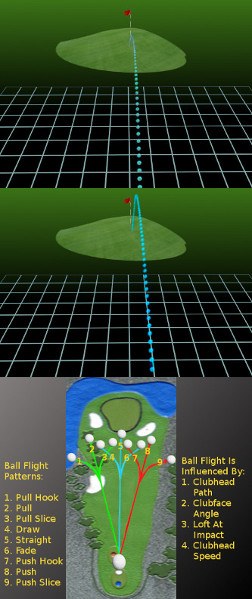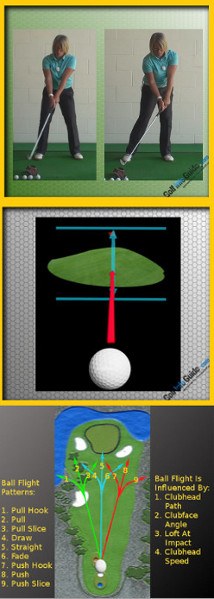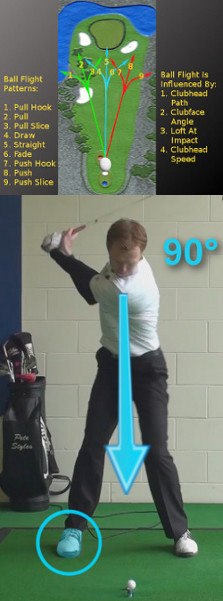
In winning the 2012 Masters, Bubba Watson showed the world that you don't need a full-time instructor or a textbook swing to play extraordinary golf. For some, great imagination and a “see-ball, hit-ball” mentality are more than enough.
Watson defeated Louis Oosthuizen in a sudden-death playoff by executing a seemingly impossible shot – a 40-degree hook with a wedge, from the woods, that settled 10 feet from the cup. The shot was a perfect example of Watson's style. The lanky, 6'3” Floridian has never had a golf lesson and never reviews video of his swing to see his potential problems. He's ascended to the ranks of golf's elite on pure talent and creativity.
Watson's signature: His swing has more than a few unique moves. For example, Watson's right shoulder (he's a lefty) touches his mouth as he completes the backswing, and his feet are extremely active for a tour pro. But what really sets Watson apart is the way he approaches each shot.
With Bubba, there's no such thing as “by the book.” If he believes a low fade will work best on a certain drive, that's what he hits. If a high draw seems like the correct play, he tries that. Even on the practice range, Watson rarely hits the same shot twice in a row. Instead, he varies shape, trajectory and distance from swing to swing.
Who else does it: No one in today's game, although Phil Mickelson comes closest. Going back a few years, Seve Ballesteros played with a creative mindset similar to Watson's. Perhaps it's no coincidence that the late, great Spaniard claimed a pair of green jackets himself.
Television doesn't do justice to Watson's shotmaking prowess. If you're fortunate enough to watch Watson in person, you'll witness shots that curve massively left and right, balls that barely leave the ground but travel miles, and moonshots that defy gravity. In addition to his ability to bend shots at will, Watson is incredibly long off the tee. In fact, he finished first or second in driving distance every year from 2006 through 2011.
Why it works for Watson: Based on his pink driver alone, it's obvious Watson thinks a little… differently from most of his peers. Like Mickelson, who has confessed that playing conservatively clashes with his personality, Watson must follow his creative instincts – rather than relying on mechanics or sticking with high-percentage shots – in order to thrive.
Of course, Watson boasts a rare ability to execute the shots he visualizes. Most of us aren't quite so blessed.
How it can work for you: Fortunately, you don't need Watson's resourcefulness to adopt his approach. The key lies in forgetting about swing technicalities and simply hitting the ball naturally.
Playing with Watson's inventive, try-anything attitude requires two primary ingredients: 1. Understanding how to control the ball's curve, trajectory and distance with different clubs, and 2. Ample time to practice hitting an array of shots, working to fix and cure flaws.
On the range, take a short iron and choose a target. Try to hit the target with a draw, then a fade. Hit a high shot, then a low one. Pick a target that's well short of the maximum distance you can hit the club, and gear back your swing to hit shots that just reach the mark. Continue hitting toward targets at different distances.
Practice this way using every club in your bag, including the driver. You'll develop a feel for shaping shots, altering ball flight and controlling distance. In time, you'll be like Bubba: a versatile, shotmaking machine, able to adapt your game to fit any course or conditions.

Bubba Watson Instinctive Shotmaking
When you watch golf on television, the game can start to look awfully similar from player to player. Most of the men and women on the professional golf tours play the game the same way – picking conservative targets, making consistent swings, and hoping to make enough putts to shoot a low score. It might not be the most exciting formula in the world, but it works. Consistency is the key to making money in the world of professional golf, so most players remain risk averse in order to keep their jobs.
The story is a little different when it comes to Bubba Watson. While Watson has been incredibly successful in his career – including twice winning the coveted Masters – he plays the game quite differently than most of his contemporaries. The way Watson plays golf is anything but ordinary, and it is anything but boring. If you get tired of the standard issue style of play on the PGA Tour, you should pay close attention to Bubba Watson. His style of play is a refreshing change of pace, and it will likely engage you from the first hole through the last.
So what does Bubba Watson do that is so much different from the rest of the players on Tour? Well, for one thing, he hits a dramatic curve on the majority of shots that he plays. As a lefty, Watson favors the right to left fade, but he is more than capable of working the ball from left to right when necessary. Even when the course doesn't demand that a curved shot be played to the target, Watson seems to be more comfortable with the idea of carving the ball through the air instead of trying to hit it mostly straight. This approach to the game requires incredible talent – talent, obviously, that Watson possesses.
The instincts that Bubba Watson has for shotmaking on the golf course are rare to say the least. If you are looking to improve your own game and you would like to learn from Watson, the first thing to understand is that you aren't going to be able to copy his style of play exactly. The talent that he has for curving the ball is reserved for the very best players in the world, and you would not be likely to achieve satisfactory results if you tried the same type of approach in your game. However, you can learn from the way that Watson thinks creatively on the golf course. Too many golfers get stuck into the conventional way of thinking, and it limits what they are able to accomplish. If you can keep your mind open to trying new things and playing new shots, you just might be able to take your game to a new level.
All of the instruction contained below is based on a right handed golfer. If you happen to play left handed, please take a moment to reverse the directions as necessary.

Expanding Your Repertoire
If you have any intention of taking Bubba's lead by starting to work the ball around the course, you will first need to expand the selection of shots that you have at your disposal each time you stand over the ball. If you are only really able to hit one shot, you can't consider yourself a 'shotmaker' – you simply won't have the variety in your arsenal to get creative throughout the round. Most golfers play just one or two shots the vast majority of the time. That is a strategy that can work, but it will never enable you to use your creativity to the max.
Before attempting any wild shots on the course your journey to becoming a shotmaker needs to get started on the driving range. Set aside some time during your next practice session to work on creating a variety of shots with a number of different clubs. To start, work on the following three points –
- Curving both ways. To be a true shotmaker, you need to at least be able to move the ball in both directions. You don't need to have total control over both of these ball flights, as one will likely always remain stronger and more comfortable than the other. However, at the very least, you should know how to set up to the ball in order to make it curve to the left and to the right. This is an ability you should develop with both your woods and your irons. On the driving range, pick out targets down range and then try to curve the ball at them from both sides. This is going to take a significant amount of time and energy in order to master, but with practice, you should be able to add both a draw and a fade to your arsenal.
- Low and high. Just like you need to be able to curve the ball right and left, you also need to be able to move the ball through the air on a high trajectory and a low one. Most golfers find that one of these shots comes naturally, while the other is more difficult to obtain. Try adjusting your ball position to move the ball up and down, and also play with different grips to see what the positioning of your hands does to the resulting ball flight. So much of this process is trial and error – you need to be willing to stand out on the range hitting different shots until you find methods that work for you. The whole point of this process is to improve your creativity and widen your horizons, so you shouldn't be looking for specific technical instruction on how to hit these shots. Instead, you should be trying to develop your instincts and your feel for the way the ball comes off the club. Eventually, you will gain confidence in your control over the ball, and a wide variety of shots will become possible.
- Soft shot. Most golfers only have one speed for their full swing – and that is all out, everything they have going into the shot. It's fine to swing at maximum effort for some of your shots, but being a shotmaker requires a little more touch than that. In addition to your flat out swing, you should also be able to take something off of the swing and gently move the ball up toward the hole. Bubba Watson is known around the world for being able to smash the ball – and he can certainly can do that – but he can also hit soft shots when necessary to place the ball near the target. Remember, your round of golf will be remembered for your score rather than how far you hit the ball, so you want to have as many tricks up your sleeve as possible in order to navigate the course successfully. Adding a soft swing to the rest of your hard swings can pay off almost immediately.
Before you start to change the way you attack the golf course, you first need to have these three points covered. Spend some time on the range working on your swing, and find a way to curve the ball in both directions, hit it high and low, and make some soft swings. With progress made in all of these areas, you may be ready to take an alternative approach to your next round of golf.

Seeing the Whole Course
What do you look for when you step up onto the tee of a par four or par five? If you are like most golfers, you pull your d river from the bag, aim at the middle of the fairway, and hope to hit the ball as straight and as far as possible. You might have some minor success with this method, but you also might find that you spray the ball around the course without a specific pattern. By just hoping to hit it straight, you are really leaving yourself open to missing on either side of the fairway. Missing both ways is a hard way to play golf, as it is only a matter of time before you find your ball in serious trouble. Instead, try viewing the entire hole when you stand on the tee, and pick out a path and shot shape that will steer you as far away from the trouble as possible.
To better understand this concept, picture the following scenario – imagine that you are standing on the tee of a long par four which is guarded by water all the way down the right side of the fairway. Obviously, in this case, you would love to split the middle of the fairway, but the main objective of this tee shot is to stay out of the pond. You don't want to be in the left rough, but the left rough is certainly preferable to the water on the right. The water will cost you a penalty shot, while the rough will only make your next shot a little bit more difficult.
In order to give yourself the best chance of staying out of the water, consider hitting a shot that curves from right to left. You can aim the shot down the right center of the fairway, and curve it back toward the middle. If you hit a nice little draw, the ball will be perfectly in the middle of the short grass. Even if you 'overcook' it and hit it it into the left rough, you should still be in good shape. And, best of all, as long as you get the curve right, you will be sure to avoid the water and the penalty shot that comes along with it.
Turning the ball away from trouble throughout your round is just one way to use your shotmaking ability to improve your score. Penalty shots have no place on your scorecard when you are trying to post a good number, so think strategically and use shot shapes that are going to make it highly unlikely that you will find your ball in the water, out of bounds, or anywhere else undesirable.
This same kind of thinking can be applied when playing approach shots into the green. Naturally, the target for an approach shot is the actual hole location, but you can't always aim right at the hole with a straight shot. If the hole is cut close to the edge of the green where a bunker or pond is waiting to catch an errant shot, you will need to exercise good judgment and play to the wide side of the green. You aren't going to make as many birdies by playing safe away from the greenside trouble, but your score will be better for it in the end.

Aggressive Shotmaking
Just as your shot shapes can be used to steer your ball away from trouble, they can also be used to set up birdie – or even eagle – opportunities. Bubba Watson has become a crowd favorite because of the incredible shots that he is able to produce, and he makes plenty of birdies as a result. Bubba has set a standard that you shouldn't expect to match, but you certainly can make a few more birdies of your own by using shot shapes to play aggressive golf.
The list below includes three ways that you can use creativity and shotmaking ability to present yourself with more birdie and eagle chances.
- Curve toward the hole. This is the opposite of the idea mentioned above, and it is one that Bubba Watson employs on a regular basis. Instead of turning the ball away from the hole to avoid trouble, you can decide to use a curve that will start the ball on the wide side of the green and move it right in toward the target. For example, if the hole is cut on the far right side of the green, you can start your shot at the middle of the green and use a left to right flight to get closer to the hole. The upside of this shot is obvious – if you pull it off just right, the ball will land near the hole and roll even closer, setting up a great chance for a birdie. Of course, that upside comes with a risk, as you could overdo the curve and wind up missing the green on the short side. Then, you would be left with a difficult chip and you may wind up walking off with a bogey instead of the birdie. When you are in the mood to be aggressive with your shotmaking, curving the ball toward the hole is a great option, as long as you understand the risks before hitting the shot.
- Run up on a par five. Most par five holes (but not all) offer a 'run up' path to the green. Even if the green is partially guarded by a bunker or even a water hazard, there is usually a run up that can be used to get golf balls (as well as people) onto the putting surface. Since this run up usually doesn't go right up to the putting surface from the middle of the fairway, you may need to carve your second shot to match the run up if you want to set up an eagle putt. This kind of shot requires creativity along with plenty of nerve, because there are certainly more than a few ways this can go wrong. You will likely be hitting a long club into the green if you are trying to reach in two, and you will have to get the line just right if you want to actually find the green. Also, you need to take a look at the slope of the run up before trying the shot – will the slope of the ground allow your ball to track up onto the green, or will it send it away? If the slope of the run up goes in the wrong direction, the better bet may be to lay up and try to make a birdie with your wedge.
- Go for the green from trouble. No matter how good of a shotmaker you are, trouble finds every golfer sooner or later. If you find yourself in the trees – or at least, behind a tree – you may wish to pull out one of your creative shots in order to take a run at the green. Sure, you could just punch out and take your chances with the next shot, but what fun would that be? Part of the point of developing new shots is having the chance to use them in order to get yourself out of a difficult situation. Pull your big hook or slice from the bag when you are behind a tree and hit that miracle shot that no one saw coming. You aren't going to pull off these kinds of recovery shots successfully every time, but they certainly will be memorable when they come off just right.
Bubba Watson is not known as a conservative golfer, and he certainly didn't win two Green Jackets by playing it safe. He hits plenty of incredible shots, and makes plenty of birdies as a result. His approach to the game might not be conventional when compared to the rest of the players on Tour these days, but it has been highly effective – in large part because of his willingness to take chances. There is something to be said for picking out the smart shot, but there is also something to be said for accepting risk and trying to hit a great shot while taking on the hazards that the course has presented.

Trust Your Gut
No one else can tell you when you should play an aggressive shot and when you should be conservative. One of the most important skills you can develop as a golfer is the ability to understand and trust your own identity. A shot that another golfer would see as being too risky you might see as being doable – and vice versa. You don't have to play golf like anyone else, you just have to play confidently like yourself. If that means going for the green on par fives nearly every time, or maybe laying up most of the time instead, that's fine. Your style is going to be your style, and you shouldn't feel like you have to apologize for it.
Bubba Watson trusts himself on the golf course – that much is obvious. Very few players would try to play the kinds of shots he pulls off on a regular basis. If another golfer on Tour tried to play like Bubba, they would likely fail miserably. At the same time, Bubba would likely fall far short of the standard he has set for himself if he were to try imitating the style of another player. The shotmaking, risk-taking style works great for Watson, which is why he has been so successful. Your objective should be to find your own style, and then build trust in it so you can be confident in your shot selection no matter the circumstances. You shouldn't feel compelled to play a hole a certain way just because everyone else in your group took that path – use your creativity, along with your shotmaking ability, to forge your own approach.
As you should already know, expecting to carve the ball around the course like Bubba Watson would only be setting yourself up for disappointment. There is only one Bubba Watson in the golf world, and you aren't going to be replicating his style of play (or his results) anytime soon. With that said, you certainly can strive to make yourself a better ball striker and a better all around player with the addition of some new ball flights. By teaching yourself how to turn the ball in both directions, along with adding the ability to hit it both high and low, you will suddenly find that there are plenty of different ways in which you can play any hole. Not only will these newfound paths open up the possibility of shooting lower scores, you should also have more fun along the way.







